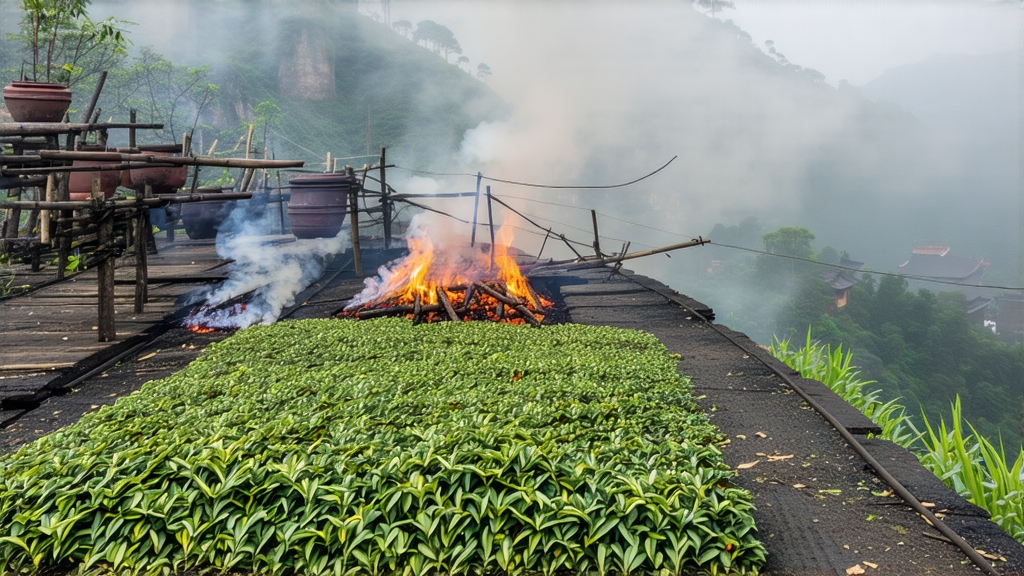
When European tea caravans first reached the bustling ports of Amsterdam and London in the early seventeenth century, the chests they unloaded carried an aroma no one had ever encountered: a sweet, resinous perfume that seemed to marry campfire and fruit. That fragrance belonged to Lapsang Souchong, the earliest black tea ever created and the forebear of every Assam, Ceylon, and Keemun that later colonized the world’s teacups. Today, connoisseurs still argue whether its signature smokiness is a rustic accident turned art, or a calculated response to the damp mountain air of northern Fujian. Either way, the story begins in the Wuyi Mountains, a UNESCO World Heritage labyrinth of basalt cliffs and cedar-lined ravines where monks once pressed tea cakes for the Song emperors.
Local legend places the birth of Lapsang Souchong at the Tongmu Guan pass around 1568, when a Qing dynasty army unit commandeered a tea factory during the harvest rush. To dry the leaves before nightfall, workers hastily spread them over fresh pine fires. The next morning the tea had absorbed the smoke, but instead of discarding the “ruined” batch, merchants discovered that the Europeans, already fond of tarred whiskey and smoked herring, adored the flavor. Thus was born “Zheng Shan Xiao Zhong”—“Small Leaf from the Original Mountain”—later Latinized by the Dutch as Lapsang Souchong.
True Zheng Shan Xiao Zhong can legally be produced only within the 600-meter contour of the Wuyi core zone, an area smaller than Manhattan. Here, the Min River funnels humid subtropical air into cool mountain basins, creating a 70 percent average humidity that slows leaf withering and concentrates amino acids. Two indigenous cultivars dominate: the petite-leaf Cai Cha, prized for its cocoa note, and the broad-leaf Da Bai, which lends malt and dried-longan sweetness. Spring plucking follows the lunar calendar: Qingming raindrops must have fallen at least twice before the first bud-and-two-leaf pick, ensuring the bush has absorbed enough mountain minerality.
Crafting Lapsang Souchong is a six-act drama performed without a script, timed only by the senses of the master. Act I, withering, unfolds on slatted bamboo racks set inside Qing-era wooden huts whose walls are impregnated with decades of pine smoke. Over eight hours the leaf loses 60 percent moisture, curling into a loose twist while inhaling the ambient resin. Act II, rolling, was once foot-powered—men in straw sandals trod bamboo cylinders—but today dual-disk machines mimic that rhythmic compression, rupturing cells and releasing grassy volatiles. Act III, oxidation, happens inside shallow rattan baskets nested inside a pine-wood cupboard. Every fifteen minutes the tea master lifts a handful to his cheek, testing for the precise warmth that signals conversion of catechins into theaflavins; the moment the leaf edge turns maroon, he pronounces “sufficient” and the pile is scattered to halt the process.
What follows is the step that separates Lapsang from every other black tea: smoke-drying. A lower hearth of local Masson pine is lit, allowed to flare, then smothered until it exudes a cool, aromatic smoke. The tea is spread on sieves one meter above the embers for three to four hours, absorbing guaiacol and syringol—the same phenols that flavor German Rauchbier. Crucially, the fire must never become hot enough to cook the leaf; the goal is cold-smoking, like Scottish salmon. Finally the tea is sorted by eye and hand, removing stems and yellow leaves, then rested for thirty days so the smoke molecules integrate, softening from blunt campfire to lingering pipe-tobacco sweetness.
Western supermarket versions often exaggerate the smoke, turning the tea into liquid bacon. Authentic Tongmu Lapsang is subtle: dry leaf smells of pine sap and dried apricot; the liquor glows copper under a ring of golden bubbles; the first sip delivers cocoa, then raisins, then a cooling camphor note that Chinese tasters call “mountain air.” The smoke arrives last, not as a layer but as a frame, the way a whiff of woodfire clings to a wool sweater long after the hearth is cold.
To brew Lapsang Souchong gongfu style, begin with soft water at 95 °C. Pre-warm a 120 ml porcelain gaiwan, then fill it one-third with